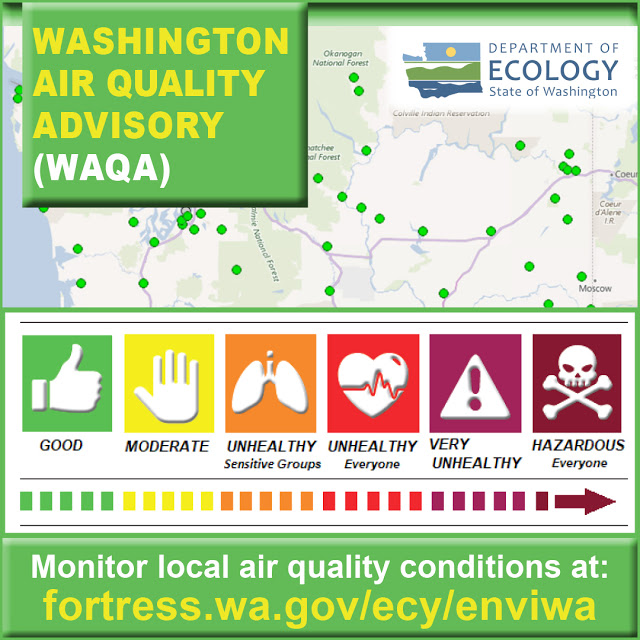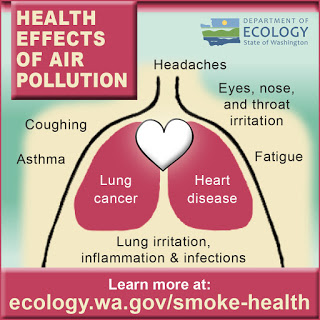
Did you know that April 29-May 3 is Air Quality Awareness Week? There's not much in this world that is more important than having clean air to breathe, so it makes sense to take a little time to appreciate the air around us — and the hard work that goes into keeping that air clean.
In Washington, Ecology, the U.S. Environmental Protection Agency, tribes, and local clean air agencies maintain a network of more than 90 air monitoring stations that continuously measure air pollution. Using continuous monitoring data, we can let you know when air pollution reaches unhealthy levels. Based on this information, people can adjust their daily activities to minimize unhealthy effects. That data also helps Ecology track long-term trends and identify areas where we need to do more to reduce air pollution.
National Ambient Air Quality Standards (NAAQS)
The federal Clean Air Act requires states to develop plans to monitor and reduce air pollution to protect the environment and public health. EPA sets national standards, the National Ambient Air Quality Standards, for six of the most serious air pollutants:
- Carbon monoxide
- Lead
- Nitrogen dioxide
- Ozone
- Particle pollution and fine inhalable particles
- Sulfur dioxide
Air quality monitoring
We use the Washington Air Quality Advisory (WAQA) as a tool to advise people about air quality levels. The WAQA is very similar to the national levels set by the EPA, but our state standards are slightly more protective when it comes to particulate pollution — the kind of pollution that comes from wildfires and wood smoke.
Ecology and seven local clean air agencies help keep the air clean by:
- Developing and enforcing rules about air quality.
- Regulating harmful emissions from vehicles, burning, and industrial activities, and reducing greenhouse gases that contribute to climate change.
- Issuing air quality permits and inspecting the businesses and industries that have those permits.
- Tracking air quality across our state.
- Developing plans to maintain and improve air quality.
- Informing the public about air conditions by:
- Issuing daily decisions for agricultural burn permit holders.
- Calling burn bans.
- Educating the public about making healthy, clean air choices.
Air quality and your health
Air pollution is a harmful mix of gases and toxic particles. In Washington, the largest sources of air pollution are emissions burning fossil fuels, smoke from wildfires and heating with wood, and industrial emissions. Kids, the elderly, pregnant women, and people with existing lung or heart diseases are the most sensitive to air pollution. The health effects of air pollution are a serious matter.
- Burning eyes
- Runny nose
- Coughing
- Respiratory infections
- Asthma attacks
- Bronchitis
- Chronic obstructive pulmonary disease (COPD) and lung cancer
- Irregular heart beat
- Heart attacks and cardiovascular disease
- Stroke
You can protect your health by:
- Paying attention to fire and smoke related news reports
- Staying indoors with your windows closed
- Setting your air conditioner to recirculate and using a HEPA filter
- Leaving the area if possible
- Avoiding outdoor exercise when air quality is poor
- Consulting your doctor if your symptoms are severe
What you can do to help reduce air pollution:
Every time you drive to school, use your heater or air conditioner, clean your windows, or even style your hair, your choices affect air pollution. Follow these steps to help reduce air pollution:
- Drive less
- Combine errands or use public transportation
- Switch to a zero emissions vehicle, walk, or ride a bike
- Postpone travel until the weather cools when possible
- Don’t let your engine idle
- Refuel your vehicle in the early mornings
- Don’t use lawnmowers or other small engines during heat spells
- Don’t burn yard waste, instead try composting
- Don’t barbecue or use your fire pit while it’s hot out
- Follow burn bans
- Don’t paint or use aerosol sprays until temperatures cool off
- Replace your wood stove if it isn’t certified in Washington



